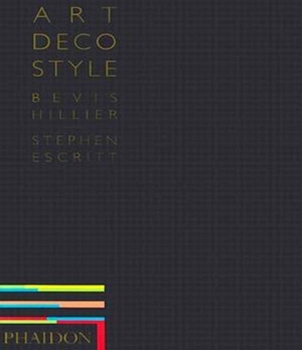Art Deco Style
Select Format
Select Condition 
Book Overview
The dominant style in architecture and design of the 1920s and 30s, Art Deco was an exuberant reaction to the austerity of the war years. Characterized by geometric shapes, stylized natural forms and... This description may be from another edition of this product.
Format:Paperback
Language:English
ISBN:0714843288
ISBN13:9780714843285
Release Date:May 2003
Publisher:Phaidon Press
Length:240 Pages
Weight:3.30 lbs.
Dimensions:1.0" x 9.9" x 11.5"
Customer Reviews
3 ratings
The Last Word in Style
Published by Thriftbooks.com User , 16 years ago
Art Deco was an applied arts movement of the early 20th Century; it was the natural successor to Art Nouveau and the predominant style of the so called Jazz Age, and thus beautifully captured the liberated spirit of that bygone time. Encompassing all of the decorative arts and industrial design to fashion, film and architecture Art Deco was an exuberant and exotic "total style" that permeated almost every sphere of 1920s and 1930s culture. Art Deco was the last great cohesive decorative arts style to evolve in Europe, but despite this apparent coherence it is paradoxically eclectic, and multifaceted. Inspired by by such diverse sources as The Ballet Russes, Cubism, Chinese, Egyptian, MesoAmerican and African art to marvels of modern technology such as speeding cars, trains, planes or cruise ships; it could be very serious, yet playful at the same time. Early Art Deco was geometric and rectilinear with a simplified design vocabulary of zig zags to stylized animal and plant motifs, such as leaping deer or greyhounds to highly stylized flowers, fronds and fountains. Later in the styles evolution Art Deco became much more simplified, using basic streamlined and abstract motifs that took the place of overt ornamentation. Stylish posters were still a major form of communication in the interwar era; being used to advertise products from alcohol to automobiles, from the latest blockbuster movie to exotic holidays aboard the Normandie or the Orient Express. One of this mediums greatest exponents at that time was A.M. Cassandra; who used posters to great and powerful effect with colourful, simple and bold graphics. Beginning in France around 1910 Art Deco's development was halted by World War I, but after the war ended spread throughout the industrialized world like wildfire. In France the style was exclusive, lavish and luxurious with a strong emphasis on highly skilled fine craftsmanship. Artists such as René Lalique, Jean Puiforcat, Demeter Chiparus, Edgar Brandt and Emile Ruhlmann all worked in costly materials like glass, silver, bronze and ivory, wrought iron, exotic woods and even shargreen or lacquer. French Art Deco reached its high peak of influence around the mid Twenties with the staging of the 1925 Paris Exposition Des Arts Decoratifs, a seminal event in its history. Sometime after the 1925 exposition the style slowly began to wane in popularity and influence with many artists, artisans and designers moving on to modernism proper. But the final death knell for this era of hedonistic opulence was sounded with the 1929 stock market crash, however, Art Deco as a style was not yet exhausted. During "the great depression" Art Deco underwent a radical aesthetic transformation with an emphasis more and more on the so called streamlining of objects; with subtle decorative touches such as "speed lines" the look was futuristic, functional and sleek. As a result of deepening economic austerity artists in the Thirties could no longer afford to use expen
New and Improved Art Deco Resource Volume
Published by Thriftbooks.com User , 17 years ago
Bevis Hillier first enlightened the world about the Art Deco movement in his definitive volume of 1968: now he adds to the strength of that fine work by joining with co-author Stephen Escritt to create probably the most complete discussion of the fascinating and important movement that influenced all of the arts in the 1920s and 1930s. Art Deco is a term applied to the reactionary period of reducing all decor to essentials in the wake of the devastation of World War I. The concept was to simplify all forms of design to geometric principals, doing away with unnecessary filigree and flotsam and maintaining a dignity of presentation. The movement influenced architecture in the rebuilding of Europe (moving into the USA rapidly as a pacesetter), book design, posters, stage decor, ballet, and even music. The manner in which each of these transformations played out (and there are many more than those listed) is the subject for this fine volume. While the book may feel a bit wordy for the casual reader (see other picture book surveys of the movement without the scholarly approach), there are ample full color illustrations to explain the theses and the aspects of Art Deco influence. Both authors write with style and clarity, making this hefty volume well worth the investment of time to read. Recommended. Grady Harp, May 06
Incredible!!
Published by Thriftbooks.com User , 25 years ago
I have about 60 books on Art Deco which I can now dispose of. This Book is the finest ever written on Deco. A real treasure.




